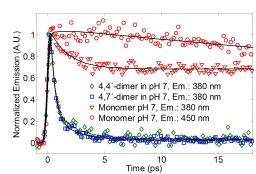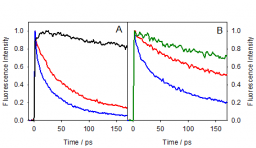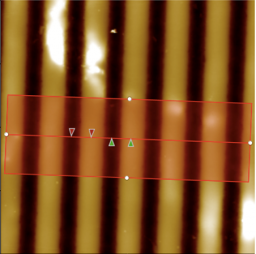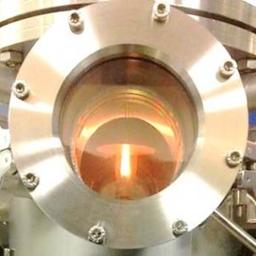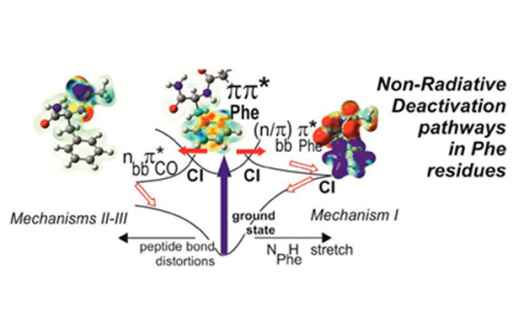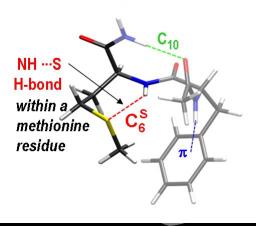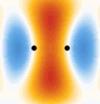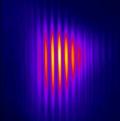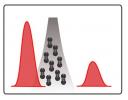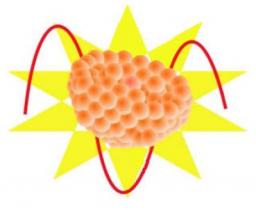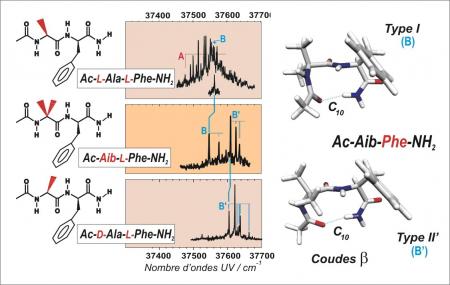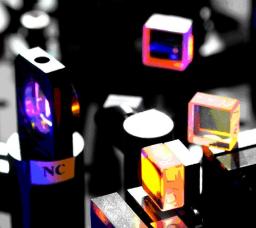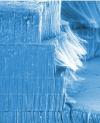Mar 02, 2015
Les mélanines sont une large classe de biopolymères responsables de la pigmentation chez l’homme. Les mélanines les plus courantes sont l'eumélanine et la phéomélanine, toutes les deux censées protéger les cellules de la peau à l'irradiation UVB, réduisant ainsi le risque de cancer de la peau.
Nov 29, 2013
Le transport et la distribution de médicaments dans l’organisme sont des mécanismes complexes régis par de nombreux processus différents. Un rôle important est joué par les protéines de transport, responsables de la fixation et la libération des médicaments.
Oct 14, 2013
L'interaction d'une impulsion laser intense avec une surface solide fait violemment osciller le cortège électronique, entrainant l'émission de protons. C'est une méthode pour obtenir une source de protons de haute énergie pour de nombreuses applications (imagerie et proton thérapie par exemple).
Jun 02, 2013
L'utilisation de silicium à l'anode des accumulateurs Li-ion permet de fortement augmenter leur capacité. Cependant ce matériau se révèle fragile et les accumulateurs résistent mal aux cycles charge-décharge répétés. D'où l'idée d'utiliser du silicium sous forme de particules nanométriques, encapsulées dans une coquille de carbone.
Mar 21, 2013
Many complex molecular systems absorb light in the UV spectral range, including those of paramount biological importance, like DNA bases or proteins. The excited states created by UV absorption are endowed with mechanisms of deactivation which are of major importance for the photochemical stability of these species. The majority of these processes are ultrafast and provide a rapid and efficient way to dissipate the electronic energy into vibration, thus avoiding photochemical reactions.
Dec 12, 2012
Ionized molecules are involved in many chemical reactions, and participate for an important part in the chemistry of the upper atmosphere and interstellar clouds. Data on the vibrational spectroscopy of these ions are thus needed to better understand the dynamics and energetics of so diluted matter.
Nov 26, 2012
La dynamique des électrons au sein des atomes et des molécules est extrêmement rapide, typiquement de l'ordre de la centaine d'attosecondes (1 as=10-18 s).
May 31, 2012
The description of the interactions controlling the shape of a protein is crucial in understanding the cellular mechanisms, but is still difficult to achieve on biological systems because of their complexity.
In this context, the use of model molecules makes accessible to experiments many biological problems lying at the heart of current societal issues. Gas-phase IR/UV spectroscopy of small peptides is an outstanding example.
Sep 24, 2011
Contact CEA : Pascal Boulanger
A decade after their first synthesis in the laboratory, carpets of aligned carbon nanotubes (CNTs) are being considered in many fields of applications (filtration membranes, passive and active electronic components, composite materials,..) combining CNTs’ individual properties and nano-structuration. But the development of these applications requires a safe, inexpensive process that is applicable over large areas.
Jan 27, 2011
One of the key research topic in the field of ultra-short laser pulses (femtosecond: 10-15 s) is the stabilization of the position of the carrier envelope (called CEP for "Carrier Envelope Phase"). An innovative device to control CEP fluctuations is offered by the CEA/SLIC (Saclay Laser-matter Interaction Centre) in collaboration with the Amplitude Technologies Company (AT).
Feb 11, 2010
S. Haessler, J. Caillat, W. Boutu, C. Giovanetti-Teixeira, T. Ruchon, T. Auguste, Z. Diveki, P. Breger, A. Maquet, B. Carré, R. Taïeb & P. Salières,
Visualizing the motion of electrons in matter requires both a spatial resolution at the Angstrom scale and a temporal resolution at the attosecond scale (1 as = 10-18 s). Such an "ultra-fast camera" opening a path towards "viewing the electrons" is demonstrated: it allows imaging molecular orbitals using the ultra-short attosecond emission from this orbital in an intense laser field.
Jul 06, 2009
Contact CEA : Hamed Merdji
In photography, the scattered light from an illuminated object is recorded with a detector and one get an image of it. If the image is formed with an objective, the optics imposes many limitations (resolution, aberrations ...). To achieve the ultimate resolution, spatially (function of the wavelength of the radiation used) and temporally (function of the "flash" duration), one possible technique (without any optics) is the coherent diffraction.
Jan 09, 2009
Fabien Quéré and the 'High Intensity Physics' Group (PHI) - IRAMIS – Service des Photons, Atomes et Molécules (SPAM)
Since the invention of the laser, thesearch for shorter wavelengths, up to the X-ray range is a permanent concern. One way to generate such XUV radiation is to focus an intense laser beam in a material. The material responds to the strong external stress in a non-linear way, producing high order harmonics of the fundamental frequency excitation.
During the last fifteen years, atomic or molecular systems are used as frequency converters.
Sep 25, 2008
Highlight in Physicsworld.com (2008 September, 19th)
Researchers from Italy, France and Germany have shown that a tabletop laser can be used to accelerate a beam of electrons suitable for use in radiotherapy. The group, led by Antonio Giulietti of the Institute for Physical Chemistry Processes in Pisa, believes that such laser-based particle acceleration could considerably reduce the size and simplify the operation of radiotherapy facilities.
May 18, 2008
W. Boutu1, S. Haessler1, H. Merdji1, P. Breger1, G. Waters2, M. Stankiewicz3, L. J. Frasinski4, R. Taieb5,6, J. Caillat5,6, A. Maquet5,6, P. Monchicourt1, B. Carre1 and P. Salieres1
1. CEA-Saclay, DSM, Service des Photons, Atomes et Molécules, 91191 Gif sur Yvette, France
2. J.J. Thomson Physical Laboratory, University of Reading, Whiteknights, Reading RG6 6AF, UK
3. Institute of Physics, Jagiellonian University, ul.
Mar 10, 2008
Contact : David Garzella
G. Lambert1,2,3, T. Hara2,4, D. Garzella1, T. Tanikawa2, M. Labat1,3, B. Carre1, H. Kitamura2,4, T. Shintake2,4, M. Bougeard1, S. Inoue4, Y. Tanaka2,4, P. Salieres1, H. Merdji1, O. Chubar3, O. Gobert1, K. Tahara2, M.-E.
Nov 13, 2007
Contact : Lionel Poisson (LFP) et Richard Taïeb (LCPMR-Paris VI)
Clusters consists in a set of several up to million atoms in condensed phase with nanometric finite size. The investigation of their properties as the function of their increasing size is sometimes presented as one way to build a macroscopic condensed world from a gas.
Mar 23, 2007
V. Brenner, F. Piuzzi, I. Dimicoli, B. Tardivel, and M. Mons
One of the great mysteries of life is its lack of symmetry at the molecular scale. Many biological molecules, like amino acids, exist a priori in two asymmetrical forms, "right” and “left”. Such molecules are referred to as “chiral” . Like the two hands, these forms cannot be superimposed but are mirror images of each other (Fig.). However, in living organisms, proteins are exclusively built up from “left” amino acids.
Mar 16, 2007
J.M. Mestdagh, L. Poisson, I. Fischer, P. D’Oliveira
Service des Photons, Atomes et Molécules DRECAM/SPAM
Service des Photons, Atomes et Molécules DRECAM/SPAM
The very new laser of the "Plateforme Laser Femtoseconde Accordable, PLFA" began to be installed last year within the Service of Photons Atoms and Molecules (SPAM). It belongs to the infrastructure SLIC, member of the European network LASERLAB-EUROPE and is thus accessible to European scientists.
Nov 14, 2005
M. Pinault1, M. Mayne-L’Hermite1, C. Reynaud1 ,H. Khodja2 ,V. Pichot3 , P. Launois3
1CEA Saclay - DSM/DRECAM/Service des Photons, Atomes et Molécules - Laboratoire Francis Perrin2CEA Saclay - DSM/DRECAM/Laboratoire Pierre Sue 3Laboratoire de Physique des Solides, CNRS UMR 8502, Univ. Paris Sud, 91405 Orsay









